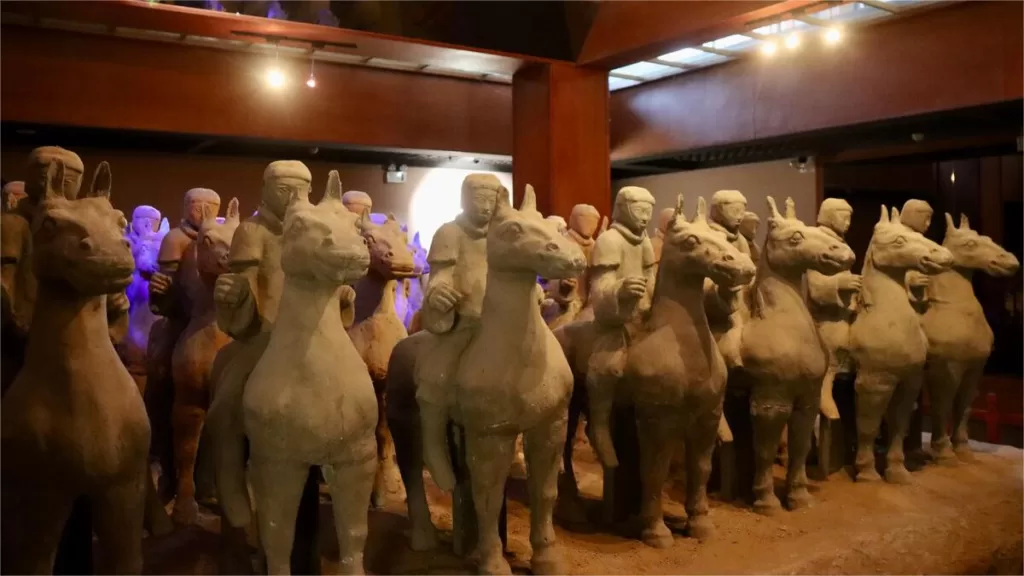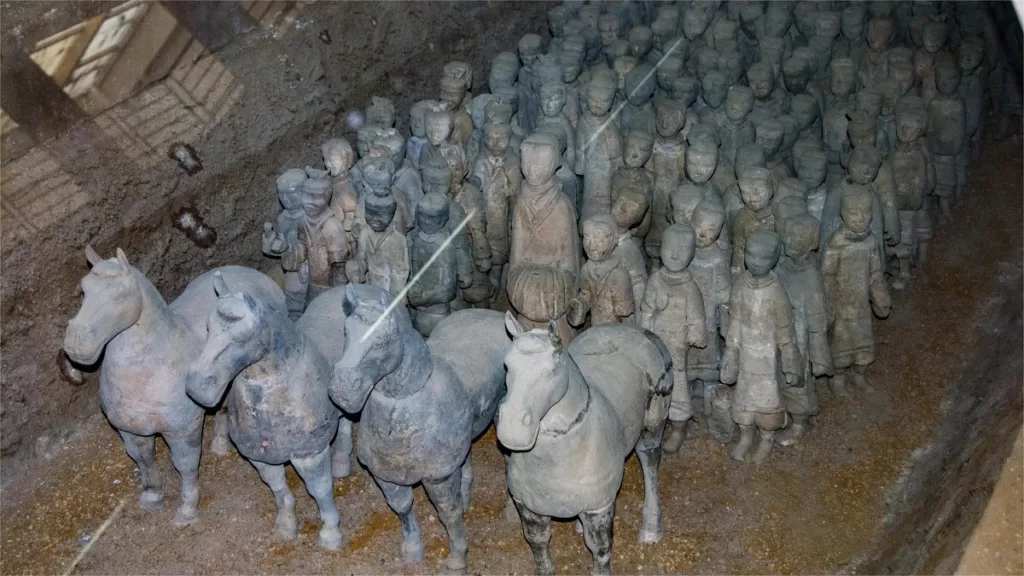The Han Dynasty Terracotta Warriors Museum in Xuzhou (徐州汉兵马俑博物馆) spans an area of approximately 6,000 square meters, showcasing the remarkable discovery made in 1984: the colorful painted terracotta warriors found about 300 meters west of the Chu King’s Tomb. This extensive underground military formation consists of six pits, unearthing over 5,000 pottery figures, including infantry, chariots, cavalry, and warhorses.
The museum features the newly added “Xuzhou Han Military Exhibition Hall,” allowing visitors to explore not only the development and layout of the terracotta warriors but also the craftsmanship. By comparing these findings with the Qin Terracotta Warriors, the Han Yangling Terracotta Warriors, and the Yangjiawan Terracotta Warriors in Xianyang, visitors gain a deeper understanding of the rich historical context specific to the terracotta warriors of Xuzhou.
Adjacent to the northern side of the Han Terracotta Warriors Museum, approximately 100 meters away within the Lion Lake, stands the unique Underwater Terracotta Warriors Museum – the only one of its kind in China. The museum comprises two square-shaped underwater structures designed with roofs resembling the architectural style of the Han Dynasty, presenting a four-sloped surface. Exhibited within are restored pits and meticulously repaired terracotta warriors submerged underwater.
Table of Contents
- Basic Information
- Location and Transportation
- Historic Background of Han Dynasty Terracotta Warriors
- Unearthed Pits in Han Dyansty Terracotta Warriors Museum
- Features of Han Dynasty Terracotta Warriors Museum
- Vlog about Han Dynasty Terracotta Warriors Museum
- Attractions near Han Dynasty Terracotta Warriors Museum
Basic Information
| Estimated Length of Tour | 1 hour |
| Ticket Price | Included in the ticket for Han Culture Scenic Area, which costs 90 RMB |
| Opening Hours | 8.30 – 17.00; Last admission: 16.30 |
| Telephone Number | 0086-0516-83167053 |
Location and Transportation
The Han Dynasty Terracotta Warriors Museum is located in the Yunlong District of Xuzhou City, Jiangsu Province, China, at 1 Bingmayong Road. To get there, you can choose one of the following ways:
Bus: Take bus 49, 65, 71, 79, 92, 97, 605, or 608 and get off at Chuwangling Stop (楚王陵站).
Metro: The closest metro station to King of Chu Tomb is Huangshanlong (黄山垅) on line 1. After getting out of the station from Exit 1, walk about 800 meters to the southwest to reach the attraction.
Historic Background of Han Dynasty Terracotta Warriors

The Han Dynasty Terracotta Warriors, dating back over 2,150 years, were originally burial companions for Liu Wu, the third generation king of the Chu State within the Western Han Dynasty, much like the Qin Terracotta Warriors accompanied Qin Shi Huang in his mausoleum at Mount Li.
The societal beliefs of the Han Dynasty were rooted in a profound reverence for the afterlife. People held the view that death was a transition to another realm where life continued. Consequently, all the material and spiritual comforts enjoyed during one’s lifetime needed to be transported to the afterlife. In the various tombs of the Chu kings in Xuzhou, amenities such as powder rooms, kitchens, treasuries, dance halls, and guest rooms were meticulously provided, even including well-crafted and fully-equipped toilets. In such a context, feudal lords and high-ranking military officers, holding significant military power, naturally aspired to command armies and horses even in the afterlife, leading to the creation of the terracotta warriors.
These terracotta warriors were crafted not merely as funerary objects but as symbols of the continuation of command and military might into the next world. The elaborate design and attention to detail in these terracotta figures reflect the deep-seated cultural and spiritual beliefs of the Han Dynasty society, where death was not the end, but a continuation of life in another realm.
Unearthed Pits in Han Dyansty Terracotta Warriors Museum

The unearthed pits at the Han Dynasty Terracotta Warriors Museum consist of three east-west oriented pits for infantry and one north-south oriented pit for sentinels. The infantry pits are spaced 5 meters apart, each measuring 28 meters in length, with a pit entrance width of 2.2 meters, a bottom width of 1.1 to 1.4 meters, and depths ranging from 0.4 to 1.1 meters. The sentinel pit is located approximately 5.5 meters east of the three infantry pits, measuring 26 meters in length, 1 meter in width, and with depths ranging from 0.15 to 0.40 meters. Additionally, there are two pits for cavalry and chariots, situated about 125 meters northwest of the three infantry pits. One of these pits was damaged in 1981, while the other measures 12.5 meters in east-west length, 3.5 meters in width, and has depths ranging from 0.4 to 0.6 meters. The pits are approximately 24 meters away from the current site. Two infantry pits and the sentinel pit have been excavated, with varying degrees of damage at the eastern ends of the infantry pits. The total number of surviving pottery figures is 2,393, comprising 1,016 from pit one and 1,377 from pit two.
Features of Han Dynasty Terracotta Warriors Museum

The pottery figures are crafted from grayish-green clay, featuring four horses, an official figurine, and the rest depicting various figures such as soldiers in armor, kneeling figures, helmeted soldiers, figures with braided hair, figures with topknots, archers, and soldiers wielding long weapons. The figures are coated with pink pigment, and some details are painted in vermilion. Based on the analysis of characteristics such as form, texture, and clothing, these terracotta warriors are believed to date back to the 1st century BCE, around the time of the Western Han Dynasty’s Jing and Wu periods.
Examining the craftsmanship, the terracotta warriors were initially molded using molds and then underwent additional sculpting processes. While they share similar sizes, careful observation reveals diverse facial expressions, each unique. Some warriors appear to be shouting with raised heads and open mouths, as if uncontrollably crying, with nearby figures leaning in or looking sideways, seemingly comforting or advising the distraught individual. Others exhibit introspective and melancholic expressions, with lowered heads, furrowed brows, and downturned mouths, conveying a quiet and somber demeanor that complements the overall solemnity of the military theme.



